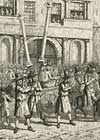Freemasons
The 'classical' European secret society clearly borrowed its organizational model from Freemasonry, which itself originated from the guilds and brotherhoods of Scottish and English masons. The official birth of Freemasonry is conventionally set at 1717, the foundation date of the Grand Lodge of London, which in 1723 issued what, after its author, became known as the Constitutions of James Anderson. These regulations were not meant to formulate a particular doctrine, but to delineate a free space in which fraternal tolerance allowed for interesting and pleasant company. As in the guilds, the (almost exclusively male) members of the new lodges passed through a series of initiations to ascending degrees of apprentice, journeyman, and master. The building trade had become merely symbolic; the candidate was seen as a rough stone that had to be polished. The lodges were endowed with a considerable autonomy and engaged in various activities, most often in the fields of charity, education, and merry socializing. Because of the substantial cost of membership, they recruited disproportionally from the more well-off. Members were held to secrecy, but as the illustration shows, this in no way excluded public demonstrations. In England Freemasonry soon became a successful and respectable institution.
The movement spread both to the English colonies and the Continent. Here, however, the authorities, fearing moral, religious, or political troubles, were much more reserved than in liberal England. The Continental lodges were frequently suspected of oppositional or unorthodox tendencies, which was of course mostly a matter of definition. The Catholic Church condemned Freemasonry in 1738, the first of many occasions. Its popularity rose quickly nonetheless, aided in part by the creation of new 'systems' that offered more than three degrees and, perhaps, a hint of hidden knowledge or a special experience. In France, on the eve of the Revolution, one in twenty city dwellers was a Freemason. This helps to explain why after the 'fall of Throne and Altar' the lodges became suitable candidates for the role of scapegoat.
Read also an anonymous early defense of Freemasonry in France (Pdf 1,5 Mb).
Source: Lettre écrite par un Maçon à un de ses amis en province, s.l., 1764 [= 1744], 23 pp. (Call number: Bro F1758/50).

